By Beetle
In my article about the Savage Trials Pistol, I discussed how Savage and Colt had a final “shoot off” to see who would win the contract to be the standard issue military sidearm. We all know the result, the Colt fired 6000 rounds without issue while the Savage had 31 malfunctions and 5 parts breakages. Therefore, the Army awarded Colt the contract on March 29, 1911 to manufacture the M1911 (or Model of 1911). Even though the contract was awarded at the end of March, it took the government and Colt some time to get production up and running. There were lots of details to sort out including how the pistols should be marked, tested, and accepted by the government. In fact, only 50 pistols were made in 1911. Today collectors call these “first day of production” pistols – they are the only 1911s actually made in 1911. Therefore, the first year of production generally refers to 1912 . . .
As soon as Colt got their military production squared away, they worked on releasing a commercial version of the Model 1911. It was introduced as the “Colt Government Model Automatic Pistol” in March of 1912. The name is confusing today, but at that time Colt wanted to reinforce the connection that it is the same gun as “what the government uses.” The pistol sold to the public at $22 versus the $14.25 that Colt charged the government.
The finish on these early Colts is very unique. At the time Colt finished the guns (even the military models) the only way they knew how – to perfection. Each part was hand polished using a series of specially designed polishing wheels. In addition, each part was polished at least four times using increasingly fine abrasives. The final polish was achieved using walrus hide and whale oil. By the time the workmen (we would call them craftsmen today!) were done, the entire gun had a brilliant mirror-like finish.
An example of Colt’s polishing wheels – note this is a later picture when Colt had already reduced the amount of polishing being applied!
After the gun was polished, it was degreased with a boiling gasoline bath! It would then go into a coal fired oven which had a layer of charcoal and whale oil at the bottom. The guns would rotate in the oven rotisserie style for several hours. Periodically a workman would come along and scrub the guns with oakum (a type of fiber) and whiting (a type of ash). This scrub would clean away any charred material as well as polish the gun even more! If that wasn’t enough, the entire process was repeated up to six times until the workman was satisfied with the color and depth of the bluing.
To say the finish looks amazing is an understatement. It is very hard to describe what the finish looks like, as it is very dynamic in nature. In direct light it has a light-blue color to it. In indirect light it has a metallic black look. If I were to summarize it looks like “black chrome”. The same gun in direct and indirect light:
In addition to the mirror-like reflective finish, Colt also applied a “fire blue” to the small parts. All of the small parts were placed into a cast iron vessel containing a charcoal and bone mix. It was heated until the small parts took on an iridescent blue color. The small parts with their turquoise color really pop against the reflective mirror-like finish.
While the finish is indeed quite handsome, the military was less than impressed. I guess the last thing you want in a battle situation is a highly reflective gun with brilliant blue accents! At the military’s request the finish was toned down until eventually the gun was mostly a dull, dark black (the so-called “Black Army” finish). Unfortunately with the switch to the dull black finish, the exact technique for the original brilliant finish has been lost in time. Not only did Colt switch from coal to gas ovens, but some of the materials are now simply unavailable — sperm whale oil anyone?
The pistol shown is my first year of production Colt Government Model. It was sold by Schoverling, Daly, & Gales, a large New York retailer of firearms. An interesting fact, it was the partners behind this retailer that started the brand “Charles Daly.” Here are a few interesting pages from their 1912 Catalog, introducing the Colt Government model for the first time (click for larger size).
Happy Birthday! This gun was shipped today (November 27), way back in 1912. Even at 101 years old, this old Colt is as functional and beautiful as ever!
About the author: Beetle is an amateur collector, writer, and photographer. His favorite FFL had this to say to him: “you like all the weird stuff.” He can be reached at [email protected].


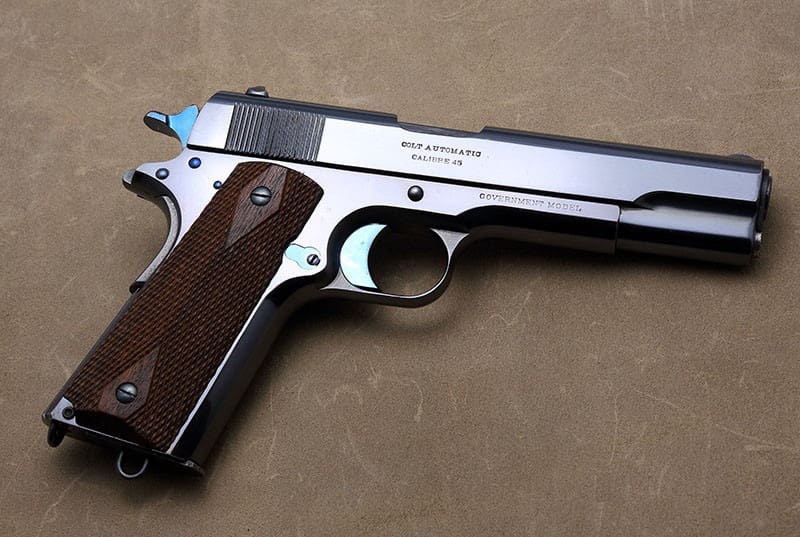


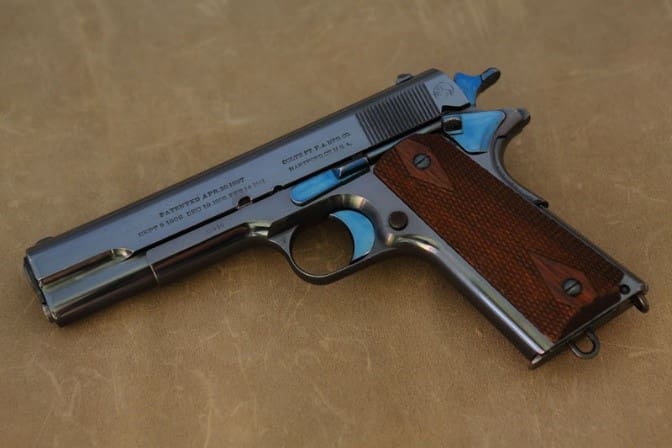
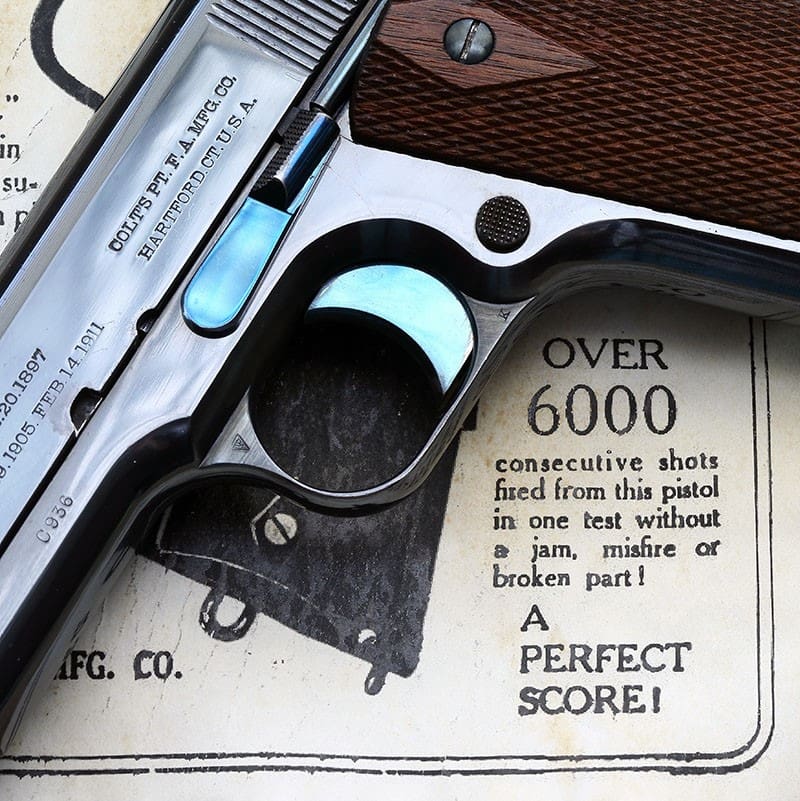
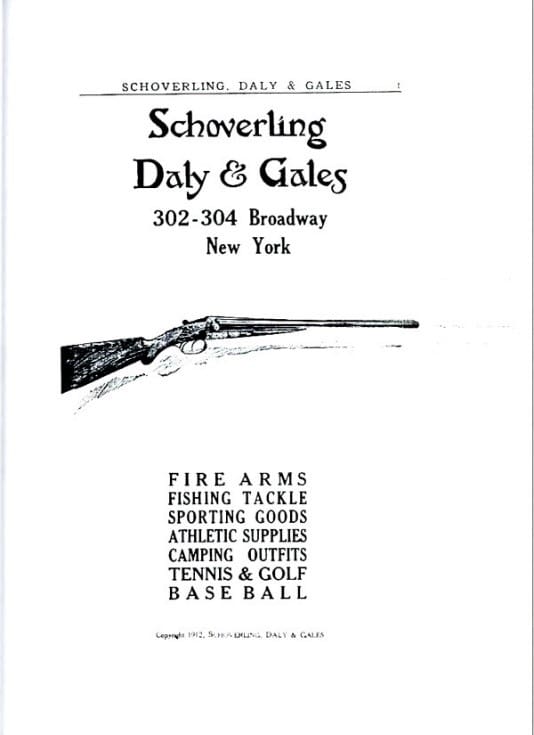
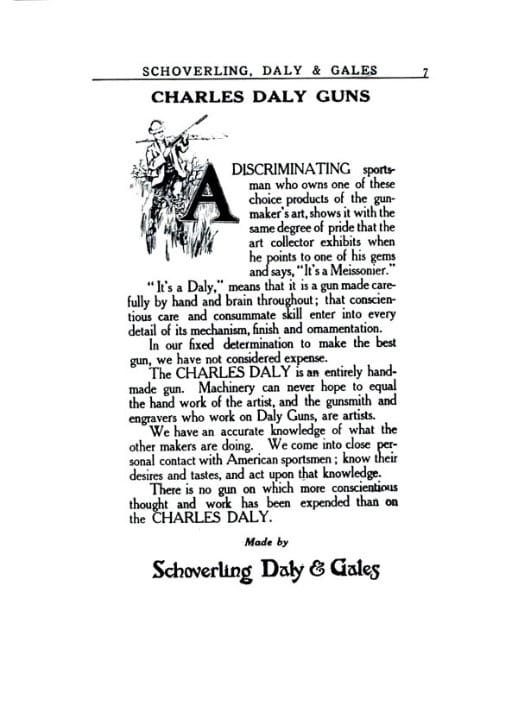
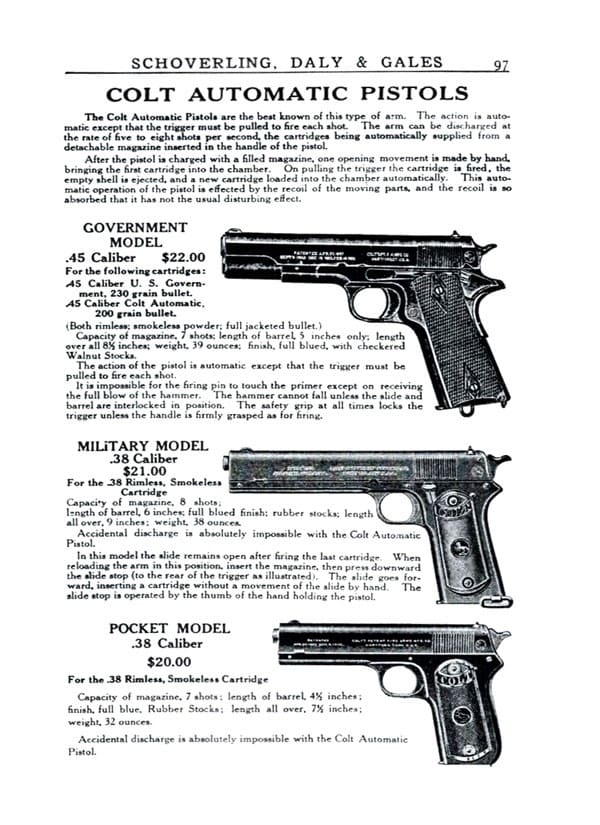
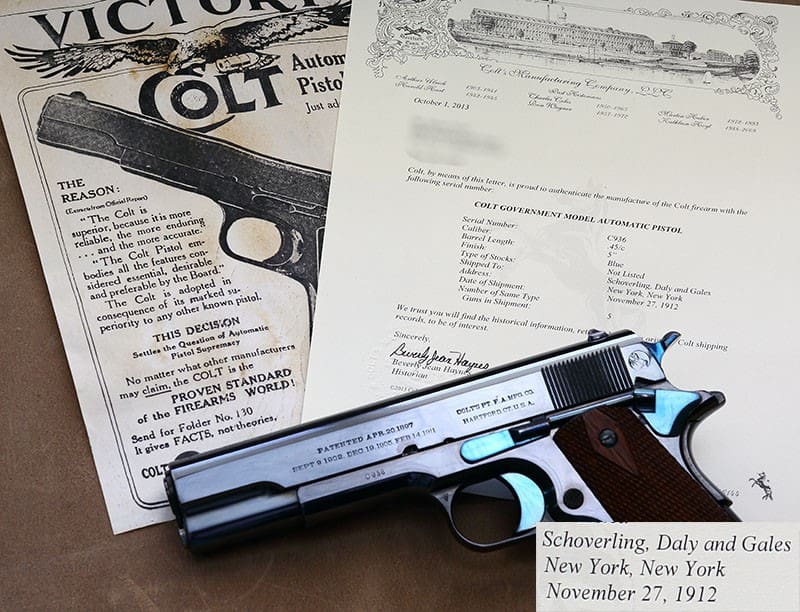



Holy crap!!!
Look at the condition of that old war horse!
My gosh, that is stunningly beautiful.
Now that… that there is simply gorgeous. [SIGH]
I have the strangest boner right now…
Glad I’m not the only one. And I’m not even a 1911 guy!
It would be strange if you didn’t have one!
It may be blue or black, but I know I’m green. . .
And to think, the price has not changed that much. A double eagle and 2 silver cartwheels.
+1
…just made my day.
I’m not a 1911 guy but that is one damn pretty piece of equipment.
I’m just going to leave my review of this article at “gun boner” and say no more.
Is it a sideways boner?
Those are very strange.
My Blue Book from a few years back lists the value of such a 1911 at $15,000 in 98% (for 100% is says “N/A”).
That one sure looks 100% to me. I mean, I know it isn’t, but it looks it.
Gorgeous.
Simply stunning. Love the early 11’s with the deep radius cuts on the slide. I had read some stuff about how Colt blued those pistols but had never heard the part about sperm whale oil. Thanks for the interesting read, and the incredible pictures. Just curious…..ever fire it?
Wish I could have that. But I guess I’ll be happy when I get my rock island 1911 layaway paid off. Happy….but never satisfied.
Wow!, that is one fine firearm.
And now people start to understand my rants about the low quality of of firearms being sold to the American gun buyer. All you guys who have until now thought I was just some raving nutter, some cranky old SOB, piddling on your dreams of owning some dura-coated tacti-cool gun as wanna-be gun owner status… now look at those pictures.
Read what Beetle writes about the subtlety and depth of that finish. If you had a nice, clean set of cotton gloves and Beetle very graciously allowed you to handle that 1911, and you could turn it over and over in the light, especially in natural light… you’d have an inconvenient development that would prevent you from standing up in public.
Look at the quality of that finish. Go ahead. Tell me where you can buy that today. Go ahead and try to convince me that paint-on/bake on finishes make you tumescent the way that pre-war carbonia blue job does. Go ahead, tacti-cool kids: Try.
Beetle: The blueing on the small parts is referred to as “charcoal blue,” and like the carbonia oil blue job, has to be performed in an atmosphere furnace. Many, many thanks for this write up. It makes me seriously happy that there are other TTAG readers who appreciate really nice, high-quality firearms and Nice Guns[tm].
One of the things that has changed in the last century is that labor used to be cheap and technology was expensive. Now labor is expensive and technology is cheap.
A hundred years ago that $22 was a month’s salary if you had a decent job. And that was long before the 40 hour workweek was invented. Most people part with 2 or 3 days wages for a new firearm and we tend to like it that way. We’d rather have night sights than a fine polish. If our priorities hadn’t changed I’m sure the firearms industry would cater to wishes.
Thank the Federal Reserve and a deliberate policy of constant inflation and devaluation of our currency to suit the bankers that own the Fed.
The federal government also caters to our wishes. We want handouts from the government but we don’t want to know we are being taxed for them so they give us inflation. What do you think inflation is? It’s taxation.
Currency conversion aside, we are much richer than we were in 1911. We work 40 hours a week, we eat fresh fruit in the winter, and check TTAG on our i-phones. But it still takes a man 40 hours to put a finish on a gun like that.
The Fed isn’t the federal government, nor is it run by same.
“The seven-member Board of Governors is a federal agency. It is charged with the overseeing of the 12 District Reserve Banks and setting national monetary policy. It also supervises and regulates the U.S. banking system in general.[57] Governors are appointed by the President of the United States and confirmed by the Senate for staggered 14-year terms.[32]”
http://en.wikipedia.org/wiki/Federal_Reserve_System#Board_of_Governors
Define a quality finish. The level of polish and shine of my near mint 1921 vintage 1903 colt is amazing to me. However, the functionality of the ceracote on my lionheart lh9 is amazing to me. Beauty is one quality and function (rust prevention, ease of cleaning, and inherent lubricant qualities) is another.
This level of blue job is to guns what the works of Renaissance masters are to art.
Spray-on finishes might be functional, but they’ll never be evidence of the highest levels of skill in gun finishing.
They’ll also never cause a gun to command a five+ figure price tag in the gun market.
Money follows scarcity and real skill is a scarce thing. We Americans seem to forget that in this day and age, when our cars look pretty much the same as every other car on the road (instead of the refined elegance of Packards, Duesenbergs, Caddy’s, etc), many people think food comes from execrable “fast food” joints instead of restaurants run by chefs with real skill, and people buy houses that are mass produced like cardboard boxes.
I appreciate what you’re saying, and I understand. Overall, however, the engineering evident in cars and guns is unsurpassed today. No Packard went 200k miles with 15k mile oil changes. Works of art are not well suited to day in and day out use. Modern, well engineered machines are, however.
Most of your 15K oil change intervals today are due to lubrication engineers, not engine designers.
But back to the topic: My issue isn’t against functional finishes. It is that you can’t get the art anymore. You cannot go out to any of the major 1911 gun makers and get that level of finish today – for any amount of money. There’s money out there to buy that level of finish. The gun makers, many of whom now have management infected with MBA’s, won’t cater to people who want quality. It as if the gun makers’ management wants to disclaim any prior involvement with making such a piece as you see above, then tell you that a spray-painted piece of crap is a replacement for the Mona Lisa. It’s an insult to my intellect to talk to these people.
The Europeans get it. For example: You can go buy a new Luger – very nicely finished. Krieghoff made a run of 200 Lugers:
http://www.krieghoff.com/pdf/Parabellum%20Flyer.pdf
Very nice work. $8K or thereabouts, last I inquired for someone. The point isn’t the price – the point is that they still make such an item at all.
Another example, let’s take high quality shotguns. There is a veritable river of money going to Europe (especially Italy) to purchase high quality shotguns. Some of these are Very Nice Guns[tm]. Five figure guns. Where are the American companies who look at that river of cash and say “Hey, let’s go get some of that money!”
Nowhere. They’re interested in catering to the lowest common denominator. They’re much more interested in peddling to me a piece of black plastic and parkerized steel, with a wanker rail on it.
It used to be that Winchester, Remington, Colt, et al, all had “custom shops” that would put out the highest level of a gun that you could afford – and the options, finishes, etc were all listed in their catalogs. Not anymore. I think S&W is the last outfit that might have an echo of the old ways. Thanks to the never-ending torrent of stupidity issuing forth from business schools across this country, the management of American manufacturing and gun makers want to cater to the lowest possible price point, and ignore the people who have taste and money. So the money goes off-shore to Europe to buy quality guns, when we used to make quality guns here – as you can see evidenced above. BTW, Colt used to make a rather nice side-by-side shotgun, too, believe it or not; most of them were custom orders.
If someone today were making a 1911 of the above level of quality, I wouldn’t blink an eye at forking over $4K to $5K for one – because I know what it takes to make one and I know that it will be more, not less, valuable in 10 to 20 years.
So I take it that you are not impressed with the quality of the work out of Colt’s custom shop? (At least the pictures in the catalogue are purty.)
gunsmith is obviously a man of good taste! 🙂
thanks for chiming in with detailed technical knowledge — very much appreciated!
Colt makes a good little side business out of high dollar SAAs, it’s a shame they don’t do the same with the 1911s. They did have a WWI reproduction a few years ago, and they have plenty of tacti-blingy, overpriced rail guns, but if they could replicate that finish it would make a worthy high dollar collectible today. Not like there’s a lack of 1911 buffs out there.
I’m sure if the could make a reproduction of one of these; http://www.coltsmfg.com/Catalog/SpecialEditions/1877BulldogGatlingGun.aspx , they could make a reproduction of the original 1911.
You can’t reproduce the carbonia blue process, because we can’t obtain sperm whale oil any more.
People have no doubt wondered about how often I’ve mentioned sperm whale oil here before. It is no lie or exaggeration on my part how important sperm whale oil used to be in fine gun making, not to mention other fine machinery 100 years ago. It really was amazing oil.
I’m not saying the process has to be exactly the same as long as the finished product is sufficiently similar.
So even back then the gun companies were screwing the people.
WTF? Are you referring to that work of art being created by a skilled artisan as some sort of screwing over? I’d like an explanation for this comment and it had better not be; It’s George Bush’s Fault.
military bulk buys are alllways going to have alower per-unit prictag than civlian MSRP’s becuase colt cant turn a profit on civlian sales at the bulk price point. also the U.S Military tends to stick with one gun from a given manufacture for while, making just getting that first contract a seriouse business priority, which would likly be worth selling them at manufacturing cost if historical precident is any idication. not that i know of any defense contractors that have made that call, just saying hypothetically that would be worthwhile investment.
The military also wants the “lowest price bidder” (or they used to, before DC and defense acquisitions became mobbed up with crony capitalists).
In Ye Olde Days, this was one of the reasons for the parkerized finish on military weapons. Parkerizing is cheap, cheap, cheap to do. Any semi-competent fool can parkerize a gun. No high-level polishing is required. You polish to 180 to 240 grit, then you plug the bore or any tight recesses, dump the part into the manganese or zinc phosphate solution at the correct temperature until it quits giving off little champagne-like bubbles. Maybe 15 to 20 minutes, wha-la, you’re done. No extensive polishing, no carding, no nothing. Parkerized finishes also hold a lot of oil in the microscopic fissures on the finish, which helps keep the weapon from rusting.
Parkerizing is easy. It’s easier than spray-on/bake-on finishes. It’s easier than blueing. It’s easier than e-less nickel (not by much, tho e-less nickel is pretty easy), it’s easier than chrome plating, it’s easier than just about anything else you can do to protect a gun from rust.
That level of blue job on the above civilian 1911… that takes time and talent. The time is to get the polish very even, with no dips, waves or unpolished scratches. Power wheel polishing is hard to get even, and many an inexperienced tyro will take off details, corners, edges and features with a buffing wheel. After it is highly polished without taking off details or putting in waves and dips, then comes the carbonia oil blue job in an oven, which wasn’t a low-skill job either. All of this isn’t something you can describe in a step-by-step, by-the-numbers process. Lots of polishing is done by “feel.” I can’t describe it to you unless you’ve tried to do it too, then you’d understand. There’s lots of things in guns that require not only trained eyes, but trained fingers and a trained tactile sense, and finishing on stocks and metal is one of those areas.
When it comes time to crank out guns in the quantities necessary to feed a war machine, this level of talent simply does not scale in either time or cost.
No more than GM screws the customer when it sells to fleet purchasers for less.
Try buying bullets one at a time and see if the cost is the same as by the case.
Doofus.
May not be the best out there but certainly my favorite.
May it go another 100 years and become the 1st ray gun.
Amazing is all I have to say! It would be nice if someone put out a firearm that looked like that these days. Its like looking at a rare hand built car. You can see where the human factor came in to build a beautiful completed product.
It is a beautiful weapon.
Gorgeous…perfection!
Yes. It should bear notice by Glock fanbois that this is what ‘perfection’ looks like.
Not burnt cheez-whiz.
I may be a couple of lifetimes younger than you, but I wholeheartedly agree. Todays production has lost the human touch, the little extra.
But when it comes to sperm whale oil, is there any synthetic substitute? Or will we have to start whale farms if we want to see such good bluing?
Excellent article!
Envy,envy! Covet, covet! (Heavy on the covet!)
WOW, That is a fantastic looking Colt! I wish I could see that in person. Simply stunning!
Look at that, polishing after roll-marking. Who would think of something like that?
Seriously, that is the most beautiful thing I have ever seen. Right up there above the Mauser pistol, which, although it doesn’t have the same level of finish quality, is a mechanical masterpiece.
just in case you missed it, I also did a write up on Mauser pistols recently. you can find the article here:
http://www.thetruthaboutguns.com/2013/11/jeremy-s/history-mauser-told-pistols/
And another good thing of that 1911 is that it survived all these years without any idiot scratch
Thank you Beetle…Your articles are so informative and interesting.That is simply one of the most beautiful guns ever produced. The best finished handgun I ever held was a mint blued Colt Python with that deep blue finish.I still dream of owning one some day.
I’ve said it before and I mean it — half the fun of being a collector is being able to share. thank you for responding and for the kind comments.
I agree with most of you that the era of such a finely finished weapon is past. I’m willing to settle for some of the more functiional and better/more protective finishes of new weapons. What I do miss it the perfect fit and function of a pistol like this. Not only is the finish perfect and beautiful but the parts were also fitted and polished for best feel and function. Colt sold out for the bottom line and paid the price. Even years later the Colt Python was one of the best fitted and finished firearms around. I know overpriced, overrated and a bit fragile. I have one and still remember how much I howled at the price. I did however bite the bullett and buy the thing. There is a place for quality but the masses will never be able to afford those guns. I would like to see the US gunmakers make a purpose of special or custom shop guns as a option.
I went and ran the inflated numbers and the price for this masterpiece was STUNNING… About $550 in 2013 dollars for THAT!!!!!!!
Unbelievable that Colt or anyone else could make a firearm so beautiful. Simply superb. I would give all of my pubic hair to own that piece. Those who have one of these are so very fortunate. I do not believe that our industrial might has the knowledge and capacity to duplicate this craftsmanship. Oh, well, back to my Mattel.
Comments are closed.